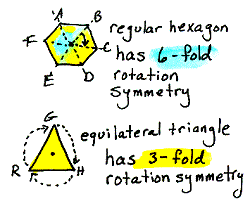 Mathematical "N" Words
Mathematical "N" Words
*Dictionary
Alert
natural number Any one of the numbers 1, 2, 3, ... . Also called positive integer. These are sometimes called "counting numbers".
n-fold
rotation symmetry
A figure has n-fold rotation symmetry, where n is a positive integer,
when a rotation of magnitude 360/n maps the figure onto itself,
and no larger value of n has this property.
 |
*n also represents the number of times the figure would need to be rotated onto intself in order to land directly in its original position. In the triangle example at left, the 3 fold rotation means that 3 rotations of 120 degrees will land point G on top of itself. |
negation of a statement A statement (called not p, and represented by ~p) that is true whenever statement p is false and is false whenever statement p is true.
EX: let p = "It is raining today." The negation of p would be, "It is not raining today."
negative integer Any one of the numbers -1, -2, -3, ... .
negative number A number which is the opposite of a positive number.
EX:
nested parentheses Parentheses which are inside other parentheses. Nested parentheses indicate which operations are to be performed first. You always work inside the INNERMOST parentheses first.
EX: (3(4+8)) means add the four and the eight first, then multiply by 3. The simplified answer is 36.
net
A two-dimensional figure that can be folded on its segments or curved
on its boundaries into a three-dimensional surface.

network
A union of points (its vertices or nodes) and segments (its
arcs) connecting them. Also called graph.

node An endpoint of an arc in a network.
nonconvex
set
A set in which at least one segment that connects points within the set
has points that lie outside of the set.
 |
Here we see the segment that connects pts. A and C contains points which fall outside of the quadrilateral. |
non-Eclidean geometry A geometry in which the postulates are not the same as those in Euclidean geometry.
nonoverlapping regions Regions that do not share interior points.
null set
The set with no elements. Also called empty set.
Either of the following symbols can be used to represent the null set.
![]()
number line A line in which the points, in order, correspond to numbers in order.
numerator a in the fraction a/b. Remember that a fraction is a division problem. The top number, the numerator, is the number being divided, the fraction bar is the division symbol, and the bottom number, the denominator, is the number of equal parts that you are dividing the top into.
EX: Say you have $24/8. Twenty four dollars divided into 8 equal parts means there will be $3 in each part.
EX: If the fraction has a numerator smaller than its denominator you might get a problem like this: $3/4. Three dollars divided into 4 equal parts. Well each of these parts will have less than one dollar in it, in this case $.75.
*If the numerator is greater than the denominator, the fraction is > 1.
**If the numerator is less than the denominator, the fraction is < 1.
numerical expression A collection of numbers and operation symbols, without an equal sign, that represents a number.
EX: 3+6(10-5) is a numerical expression that represents the number 33, because the order of operations requires us to first take (10-5), and get 5, then multiply that by 6 and get 30, and finally add 3 for a total of 33.
Home | About
Us | Algebra| Dictionary | Games | Geometry | Gym | Humor | Lab | Magic | Natural Math | PreAlgebra | Resources | Teachers Only | Toolbox | Treasures | Videos | Wonders | Writings |
Copyright © 1999-2020 themathlab.com
